Ultraman Ginga/Ultraman Ginga S Series + Movie/Ultra Fight Victory Blu-ray Movie
HomeUltraman Ginga/Ultraman Ginga S Series + Movie/Ultra Fight Victory Blu-ray Movie 
Ultraman Ginga ウルトラマンギンガ, Urutoraman Ginga / Ultraman Ginga S ウルトラマンギンガS, Urutoraman Ginga Esu / Ultraman Ginga S The Movie: Showdown! The 10 Ultra Warriors! 劇場版 ウルトラマンギンガS 決戦! ウルトラ10勇士!!, Gekijōban Urutoraman Ginga Esu Kessen! Urutora Jū Yūshi!! / Ultra Fight Victory ウルトラファイトビクトリー, Urutora Faito Bikutorī / Blu-ray + Digital CopyMill Creek Entertainment | 2013-2015 | 4 Seasons | 802 min | Not rated | Sep 15, 2020
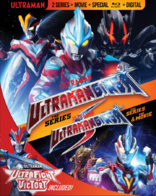
Movie rating
7.1 | / 10 |
Blu-ray rating
| Users | 0.0 | |
| Reviewer | 2.5 | |
| Overall | 2.5 |
Overview
Ultraman Ginga/Ultraman Ginga S Series + Movie/Ultra Fight Victory (2013-2015)
All of the Ultramen and monsters have been turned into figures known as Spark Dolls (スパークドールズ Supāku Dōruzu?) and became scattered throughout the universe. A young man named Hikaru Raidō finds an item called the Ginga Spark (ギンガスパーク Ginga Supāku?) which not only allows him to become Ultraman Ginga, but also allows him to go Ultraive (ウルトライブ Urutoraibu?)[2] with the figures to change them to their rightful size and become one with them. Hikaru fights with his friends to uncover the darkness behind the Spark Dolls. Alien Nackie drops a clue that the wielder of darkness resides in their very elementary school.
Starring: Hiroya Ishimaru, Takuya Negishi, Tomokazu Sugita, Kirara Asuka, ShŰhei UnoDirector: Yoshikazu Ishii, YŻichi Abe, Tomoo Haraguchi, Kengo Kaji, Yusuke Murakami
| Foreign | Uncertain |
| Sci-Fi | Uncertain |
| Action | Uncertain |
| Adventure | Uncertain |
| Comedy | Uncertain |
Specifications
Video
Video codec: MPEG-4 AVC
Video resolution: 1080i
Aspect ratio: 1.85:1, 1.78:1
Original aspect ratio: 1.78:1
Audio
Japanese: DTS-HD Master Audio 2.0
English: DTS-HD Master Audio 2.0
English movie and UFV only.
Subtitles
English
Discs
Blu-ray Disc
Six-disc set (6 BDs)
Digital copy
Packaging
Slipcover in original pressing
Playback
Region A, B (C untested)
Review
Rating summary
| Movie | 3.0 | |
| Video | 3.0 | |
| Audio | 3.0 | |
| Extras | 0.0 | |
| Overall | 2.5 |
Ultraman Ginga/Ultraman Ginga S Series + Movie/Ultra Fight Victory Blu-ray Movie Review
Reviewed by Martin Liebman October 1, 2020in its most expansive six-disc 'Ultraman' collection yet, Mill Creek has assembled two full series, one movie, and one short in a single collection. The set includes 2013's 'Ultraman Ginga' and its sequel, 2014's 'Ultraman Ginga S;' the bridge movie 'Ulraman Ginga S The Movie,' and the short-form crossover 'Ultra Fight Victory.' As with all of the 'Ultra' releases, no extras are included. However, the video and audio qualities range from substandard to superb. See below for a few thoughts on each entry and full video and audio reviews.
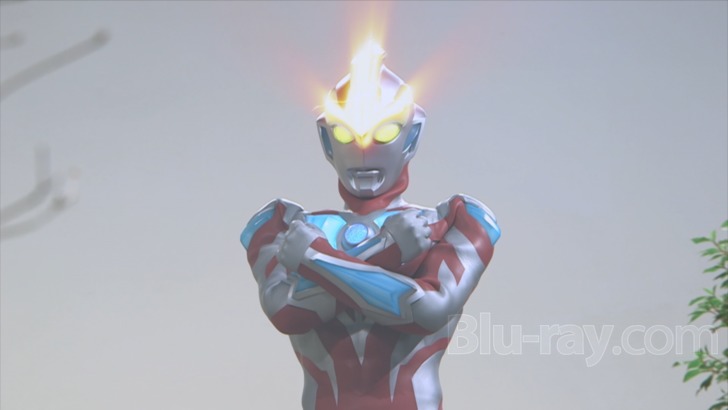
Ultraman Ginga (2.0/5.0)
Official Synopsis: Guided by a mysterious vision which appeared in his dream, 17 year old high school boy Hikaru returns to his hometown during summer vacation after traveling around with his musician parents. There he meets Ultraman Taro, the 53 meters tall super warrior but now reduced to the size of figurines called Spark Dolls by the dark force. Hikaru is told he is the 'Selected One' and that he must find the Ginga Spark and use it with the Spark Doll to transform into the gigantic Ultraman Ginga to save the Earth.
It's not often that the Ultra franchise hits a stumbling block -- a testament to just how much fun it is given all the repetition involved -- but Ginga is a fairly large one, surprising since it's one of the more off-the-beaten-path entries in the larger franchise. Unfortunately, veering away from tradition (even as it does hold to some of the core structural elements) doesn't equal "fresh." Instead, the audience is immediately aware of the cut-rate texture, the low-rent tenor, and the generally goofy approach which is not at all appealing. And it's not like the Ultra franchise is some super-structured drama to begin with. The franchise is frequently loose, often playful and light, but Ginga, which often struggles to play like anything but an extended toy commercial, never feels that way even with its best (or worst, as the case may be) efforts to the contrary. It's more likely to elicit a moan than a laugh, but the franchise was likely to reach a low at some point along its record-breaking run.
Ultraman Ginga S (3.5/5.0)
Official synopsis: 2 years after the final battle in Furuhoshi which took place in the prequel 'Ultraman Ginga', the time arrives for Hikaru Raido to have another fateful encounter with the mysterious warrior, Ultraman Victory, and a new invading force from space. With the help of the special task force UPG, Hikaru unites with Ultraman Ginga again to forge a path to the future, and a titanic tale of battles begins to unfold!
Ginga S is a superior show next its predecessor. It's more mature (yet still a lot of fun in the classic Ultra style) and more readily identifiable as it holds fast to most of the familiar tropes, including the introduction of the UPG (Ultra Party Guardians), an attack team and a concept that was absent in Ginga. It builds a quality narrative, delivers tight and robust action, creates some real drama within the storyline, and does away with the juvenile absurdities so frequently invading the previous iteration. Thatís all while maintaining the essentials introduced in Ginga. Itís the best of both worlds, then, folding in Gingaís specifics with a more comfortable Ultraman workflow.
Ultraman Ginga S: The Movie (3.5/5.0)
Official synopsis: The Earth is just beginning to enjoy its hard earned peace when all of a sudden it is facing renewed threat! With the seven Ultraman warriors being sealed up by the almighty Majin Etelgar all human hopes seem to be lost. To thwart at this critical moment, Ultraman Cosmos and Ultraman Zero come to the rescue and together they join forces with the earth defending team UPG to fight the fiercest battle never seen before..
The movie clocks in at just over an hour, the runtime of a couple of extended episodes slapped together, and indeed beyond the length there's not a significant departure from the formula. The movie offers plenty of robust action, perhaps here a hair more expansive in scope but not at all unfamiliar or uncomfortable. The movie holds to the core style, boasting no significantly superior visual effects or character beats. It's a fine finish to the Ginga storyline that sees the series' progression solidified from the juvenile Ginga to the more familiar and comfortable Ginga S.
Ultra Fight Victory (4.0/5.0)
Official synopsis: After thousands of years, a diabolical space emperor named Juda Spectre is about to break free from his dimensional prison! In order to prevent this disaster from happening, and to save the Galaxy, Earth's amazing superhero Ultraman Victory must use a new secret weapon, a combination sword and flute called the Knight Timbre! However, can the soundwave strength of our Ultraman's Knight Timbre stop Spectre and his army of monsters before it's too late?!
This short runs 38 minutes, and it's 38 minutes of everything that makes Ultraman so much fun. It's essentially a universe-building sidebar that is almost all action, features visual effects aplenty, takes place against cool enemies on distant worlds, and thrives on over the top characterization and storytelling. Who could want more?
Ultraman Ginga/Ultraman Ginga S Series + Movie/Ultra Fight Victory Blu-ray Movie, Video Quality 
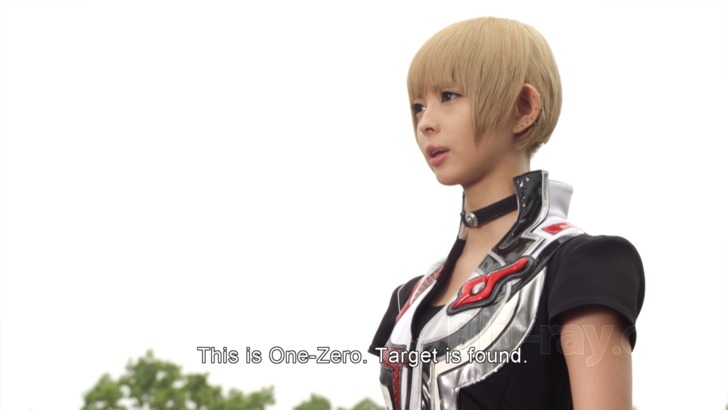
Ultraman Ginga makes its Blu-ray debut with a fairly miserable 1080i, 1.78:1-framed transfer. It's easily the worst looking Ultraman
Mill Creek has so far released, and one need look no further than episode one to witness just about the entire spectrum of problems (and the few
plusses)
that define the image. First and amongst the most prevasive issues is aliasing. Look at Hikaru's collar at the 2:30 mark for a fairly obvious, and severe,
example. A wooden panel at the 4:22 mark is another good example, as is Hikaru's luggage seen a few moments later. A fence at the 7:50 mark is yet
another and...the list just goes on for the episode and for the series' duration. Compression artifacts range from mild to moderate throughout, with
some extreme examples appearing in certain areas. Adding insult to injury, jagged edges abound, too. At times, the image just betrays the lower-grade
roots. A walk through the woods at the 10 minute mark looks downright crummy, sloppy and unkempt and nearly on the verge of digital collapse.
Unfortunately, this same infrastructure holds for the entire Ginga run. It never looks at all good in the aggregate, though there is some very
good general detail and color. Sharpness abounds in intimate facial close-ups and on various Kaiju and Ultra costumes, many of the former in particular
betraying the lower grade construction. Colors are bold, including intense reds, fresh natural greenery, and all of the many colorful bursts seen during
various Ultra-Kaiju clashes. Skin tones are generally healthy though at times appear a little pale and pasty. Black levels are adequately deep.
Score: 2.0/5.0.
Ultraman Ginga S also sports a 1080i, 1.78:1-framed transfer. However, it's greatly improved over Ginga. While it still contains some
problematic compression artifacts, aliasing, and jaggies, the aliasing is cut from "obscene" to "occasional," the barrage of jagged lines is a little less
intrusive, and the macroblocking isn't severe. Details are tighter overall, offering more reliably complex facial and clothing lines, as well as
environmental detail and Kaiju/Ultra costume clarity. Colors are richer here, too, throughout the spectrum. Perfect it is not, but a good deal better than
Ginga it is.
Score: 3.0/5.0.
Ultraman Ginga S: The Movie looks far better than either of the Ginga series. Aliasing, macroblocking, jagged edges, and noise are
all minimal to virtually nonexistent. This is the sharpest, cleanest, most reliable image of the three. Facial and clothing details are outstanding, colors
are rich and true, skin tones are spot-on, and blacks are excellent. No complaints at all with this one. Score: 4.5/5.0.
Ultra Fight Victory is the best looking of the bunch. Any problems here are minor and the image is both texturally sound and abundantly
colorful. It's interesting to see the progression from the poor Ginga to here, with every release taking steps to improve on the first's severe
shortcomings. This one boasts exceptional clarity, though many of the backgrounds have been digitally inserted and aren't quite so crisp as the live
action footage. Still, it's nice to look at and, despite a bit of noise here and there, it's a very nice looking image in total. Score: 4.5/5.0
Ultraman Ginga/Ultraman Ginga S Series + Movie/Ultra Fight Victory Blu-ray Movie, Audio Quality 
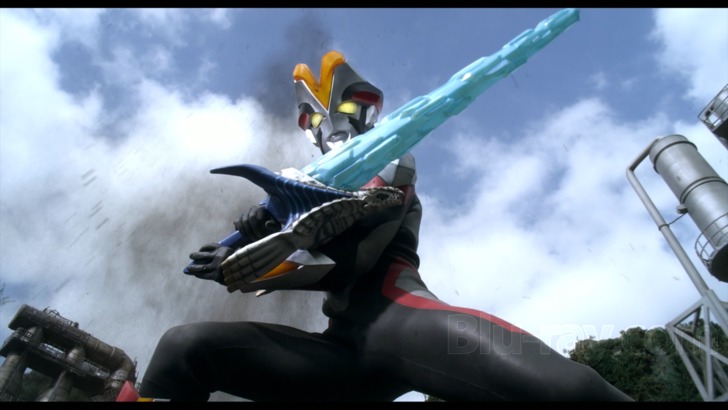
Ultraman Ginga's Japanese language DTS-HD Master Audio 2.0 lossless soundtrack, the only audio option available, is nowhere near so
engaging as previous Ultraman tracks, at least considering the more modern releases. This one's a bit flat through the range, struggling to
present even the most intense Kaiju battles with any feel for serious intensity. Even without a dedicated subwoofer channel, past franchise entries have
found a robust, engaging presence to battle. Not here. While stretch along the front is fine, including both discrete effects and movement, there's little
feel of superior clarity and engagement. Some internal dialogue late in episode one enjoys some fruitful spacing and spread, a quality feel of dispersion,
and represents some of the fullest and most fluid sound elements the series has to offer. Basic dialogue is clear and precise with good front-center
imaging. The track is not a loss; it just isn't so dynamic as so many of Mill Creek's previous Ultraman audio presentations. Score:
3.0/5.0.
Ultraman Ginga S's track, of the same configuration as its predecessor, is much the same: lacking depth at the bottom and intensity in battle.
Listen to the opening battle in the series' final episode. It's unkempt, limited in range, unable to define the elements and draw the listener into the
world with any reasonable clarity. In fact, there's a good bit of shallowness in play throughout, even with plenty of activity in play. It's a bit more
cramped in a center imaged area, too. Dialogue lives in the middle, too, where it belongs, and basic clarity and prioritization are fine. Score:
3.0/5.0.
Ultraman Ginga S: The Movie also features a Japanese language DTS-HD Master Audio 2.0 lossless soundtrack along with an English track
which is only selectable by choosing the English version from the main menu screen. It, too, is of the DTS-HD Master Audio 2.0 lossless configuration.
Both tracks share the same qualities. Action is severely shallow and muffled, so much so that listeners might be checking for blockage in the ears.
Curiously,
that's really
only during Ultra battles. The rest of the track is perfectly clear, suitably robust, and well balanced. That includes nicely spaced music, center imaged
and well prioritized dialogue, and some general action away from Ultras. That is not to say that everything is perfect. There's still a feel for modest
shallowness but it's nowhere near so severe as the action. But those shortcomings seal it as a disappointment. Score:
2.5/5.0.
Like Ginga S: The Movie, Ultra Fight Victory includes two audio options, the native Japanese and the English dub, both in the DTS-HD
Master Audio 2.0 lossless configuration. Unlike previous efforts, this one is super loud, almost too loud at reference volume. Acton is more than
spacious, taking full advantage of every inch of front end real estate afforded to it and playing with so much energy and volume and throwing so many
crystal clear elements into the mix that one might occasionally be fooled into thinking there's more going on than the front channels allow. Action
scenes find excellent depth, balance, and clarity. Music is firm, wide, and intense. Dialogue is clear, well prioritized, and images perfectly to the center.
These observations hold for both tracks. Score:
4.5/5.0.
Ultraman Ginga/Ultraman Ginga S Series + Movie/Ultra Fight Victory Blu-ray Movie, Special Features and Extras 
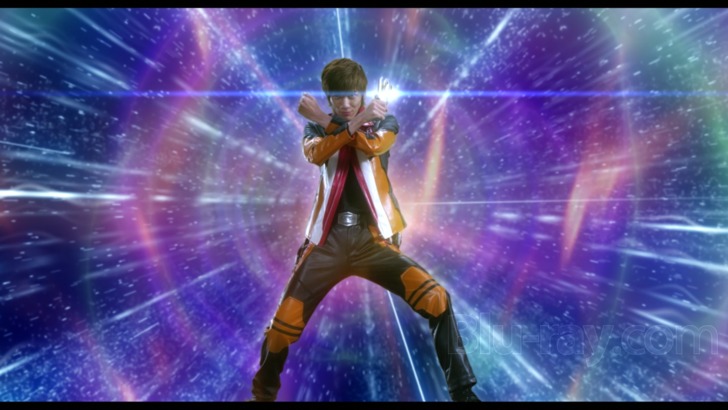
As is the norm for Mill Creek's Ultraman Blu-ray releases, there are no supplements to be found anywhere in the set. No DVD or digital copies are included. This release does ship with a non-embossed slipcover.
Ultraman Ginga/Ultraman Ginga S Series + Movie/Ultra Fight Victory Blu-ray Movie, Overall Score and Recommendation 
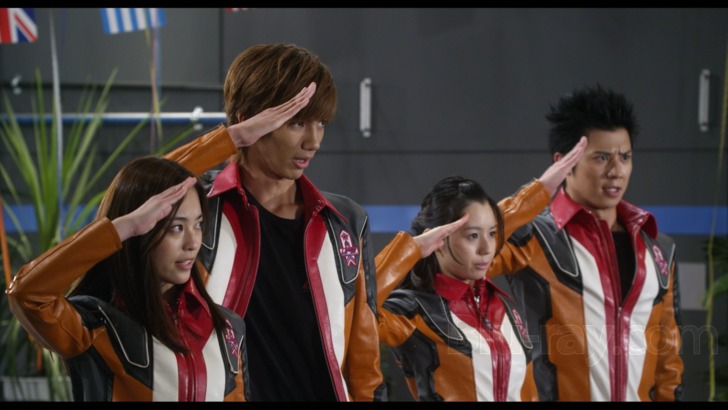
Here's hours of Ultraman fun. Sure Ginga is not the best the series has to offer, but things steadily improve with Ginga S and Ginga S: The Movie while Ultra Fight Victory is just 38 minutes of everything that makes the modern franchise so much fun. Video is sloppy to begin but improves a great deal for the two shorter programs. Audio is iffy, too, until the last short which just blows away the other tracks. No extras are included. Recommend.
Similar titles
Similar titles you might also like

Ultraman R/B
2018

Ultraman Zero: The Revenge of Belial
2010

Ultraman R/B: The Movie - Select! The Crystal of Bond
2019

Ultraman Saga
Urutoraman s‚ga
2012

Ultra Galaxy Legend Side Story: Ultraman Zero vs. Darklops Zero
Ultra Galaxy Legend Gaiden: Ultraman Zero vs. Darklops Zero
2010

Ultraman Zero Side Story: Killer the Beatstar
Ultraman Zero Gaiden: Killer the Beatstar
2011

Ultraman X: The Series
2015

Ultraman Geed
Series + Movie / ウルトラマンジード / Urutoraman JÓdo
2017-2018

Ultraman Orb
Series + Movie / ウルトラマンオーブ & 劇場版 ウルトラマンオーブ 絆の力、おかりします!
2016-2017

Ultraman Orb: The Origin Saga
includes Ultra Fight Orb
2016-2017

Mega Monster Battle: Ultra Galaxy Legends - The Movie
DaikaijŻ Batoru: Urutora Ginga Densetsu
2009

Ultraman X: The Movie
2016

Ultra Galaxy Mega Monster Battle: Never Ending Odyssey
2008-2009

Ultraman Ace
ウルトラマンA(エース) / Urutoraman Ēsu
1972-1973

Ultraman Taro: The Complete Series
ウルトラマンタロウ
1973-1974

Gridman: The Hyper Agent
1993

Ultraman Leo: The Complete Series
1974-1975

Return of Ultraman
帰ってきたウルトラマン / Kaettekita Urutoraman
1971-1972

Ultraseven: The Complete Series
ウルトラセブン
1967-1968

Ultraman Zero: The Chronicle
2017